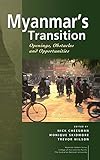Myanmar's Transition : Openings, Obstacles and Opportunities / ed. by Nick Cheesman, Monique Skidmore, Trevor Wilson.
Material type: TextPublisher: Singapore : ISEAS Publishing, [2012]Copyright date: ©2012Description: 1 online resource (392 p.)Content type:
TextPublisher: Singapore : ISEAS Publishing, [2012]Copyright date: ©2012Description: 1 online resource (392 p.)Content type: - 9789814414166
- 9789814414173
- Burma--Economic conditions--Congresses
- Burma--Politics and government--21st century--Congresses
- International relief -- Burma -- Congresses
- International relief--Burma--Congresses
- Journalism--Political aspects--Burma--Congresses
- Law--Burma--Congresses
- POLITICAL SCIENCE / American Government / General
- 959.105/3 23
- DS530.65 .M93 2011
- online - DeGruyter
| Item type | Current library | Call number | URL | Status | Notes | Barcode | |
|---|---|---|---|---|---|---|---|
 eBook
eBook
|
Biblioteca "Angelicum" Pont. Univ. S.Tommaso d'Aquino Nuvola online | online - DeGruyter (Browse shelf(Opens below)) | Online access | Not for loan (Accesso limitato) | Accesso per gli utenti autorizzati / Access for authorized users | (dgr)9789814414173 |
Frontmatter -- Contents -- List of Tables -- List of Figures -- Background on the ANU 2011 Myanmar/Burma Update Conference -- Acknowledgements -- Contributors and Editors -- Note on Terminology and Geographical Names -- Map of Myanmar -- Part I. Overview -- 1. Interpreting the Transition in Myanmar -- Part II. Introduction -- 2. White Elephants and Black Swans: Thoughts on Myanmar’s Recent History and Possible Futures -- Part III. Political Update -- 3. Myanmar’s Political Landscape Following the 2010 Elections: Starting with a Glass Nine-Tenths Empty? -- 4. Ceasing Ceasefire? Kachin Politics Beyond the Stalemates -- 5. Perceptions of the State and Citizenship in Light of the 2010 Myanmar Elections -- 6. The Burmese Jade Trail: Transnational Networks, China and the (Relative) Impact of International Sanctions on Myanmar’s Gems -- Part IV. Economic Update -- 7. Taking Stock of Myanmar’s Economy in 2011 -- 8. Reform and Its Limits in Myanmar’s Fiscal State -- 9. Devising a New Agricultural Strategy to Enhance Myanmar’s Rural Economy -- Part V. The Role of the Media -- 10. The Role of the Media in Myanmar: Can It Be a Watchdog for Corruption? -- 11. The Emergence of Myanmar Weekly News Journals and Their Development in Recent Years -- Part VI. The Rule of Law -- 12. Critical Issues for the Rule of Law in Myanmar -- 13. Myanmar’s Courts and the Sounds Money Makes -- 14. The “New” Supreme Court and Constitutional Tribunal: Marginal Improvement for Judicial Independence or More of the Same? -- Part VII. The Continued Importance of International Assistance -- 15. Rethinking International Assistance to Myanmar in a Time of Transition -- 16. European Union-Myanmar Relations in a Changing World: Time for Paradigm Shift -- 17. Prospects for a Policy of Engagement with Myanmar: A Multilateral Development Bank Perspective -- 18. Context Sensitivity by Development INGOs in Myanmar -- List of Abbreviations -- Index
restricted access online access with authorization star
http://purl.org/coar/access_right/c_16ec
With the world watching closely, Myanmar began a process of political, administrative and institutional transition from 30 January 2011. After convening the parliament, elected in November 2010, the former military regime transferred power to a new government headed by former Prime Minister (and retired general), U Thein Sein. With parliamentary processes restored in Myanmar’s new capital of Naypyitaw, Thein Sein’s government announced a wide-ranging reform agenda, and began releasing political prisoners and easing press censorship. Pivotal meetings between Thein Sein and Aung San Suu Kyi led to amendment of the Election Law and the National League for Democracy contesting by-elections in April 2012. The 2011 Myanmar/Burma update conference considered the openings offered by these political changes and media reforms and the potential opportunities for international assistance. Obstacles covered include impediments to the rule of law, the continuation of human rights abuses, the impunity of the Army, and the failure to end ethnic insurgency.
Mode of access: Internet via World Wide Web.
In English.
Description based on online resource; title from PDF title page (publisher's Web site, viewed 01. Dez 2022)


